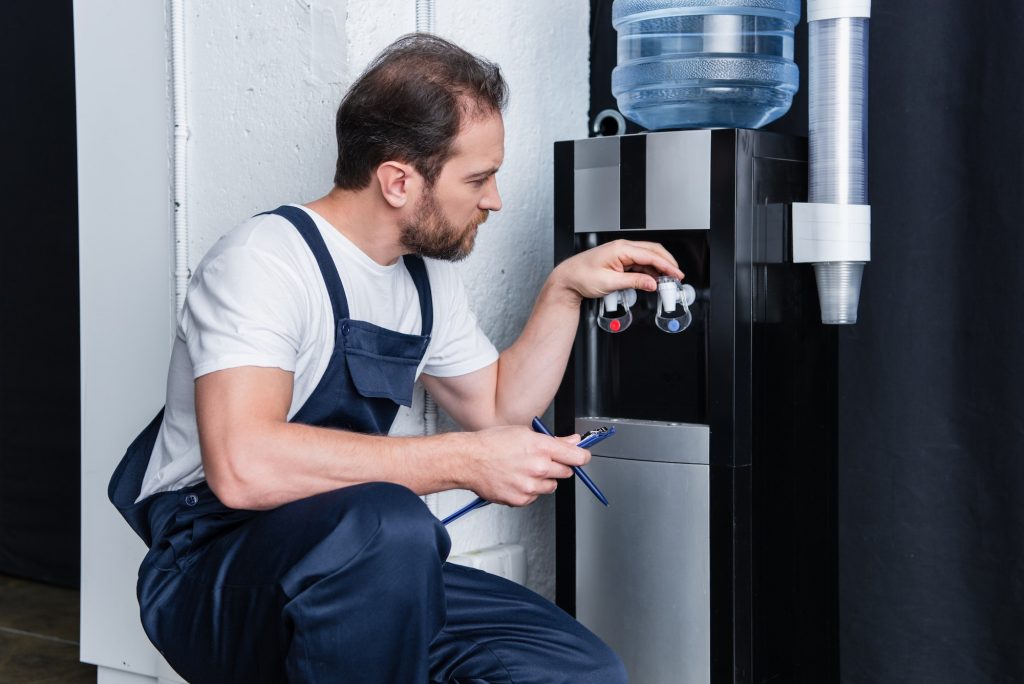Why Does My Water Look Yellow?

The water you drink looks yellow and you are not sure if it is safe to drink. Are you wondering what you can do to fix this problem? Read on to learn more about the causes of yellow water and what you can do to get rid of this problem.
What Causes My Water To Look Yellow?
When your tap water turns yellow, it may be an indicator that you have a problem with your water. There are many causes of yellow water, but most of them are relatively easy to fix. Whether you have a private well or a city supply, you should take steps to get the quality of your water back to its normal state.
The most common cause of discolored water is minerals. This can be due to old pipes, sediments, or rust. These mineral deposits can settle in the pipes, causing your water to look brown.
Another common cause of yellow water is rust. Rust is caused by the oxidation process that occurs in iron pipes. Rust can also enter the water when your water supplier has to flush stagnant areas or during maintenance work. If you notice rust in your water, you should contact your water supplier immediately.
Other potential sources of yellow water are rusty water heaters, old hot water tanks, and faucets. Using the newest model of faucets or water heaters is a good way to avoid the problem.
Another reason for yellow water is iron bacteria. Iron bacteria can be found in your pipes, water heater, or shower head. It is not usually harmful, but it can cause a bad taste in your water. You should switch to bottled water if you suspect this.
If you think your water may be contaminated with hazardous materials, you should call the water authority. Your water authority should be able to tell you what you can do to improve the quality of your water.
Is Yellow Water Safe To Drink or Use?
If you have yellow water in your home, it could be a sign of a problem with your water supply. It is always best to get your water tested and treated to ensure that it is safe for you and your family. The longer you wait, the worse your situation could get.
If you suspect that your water is not safe to drink, you should consult a plumber immediately. A professional can also help you get your drinking water back to its natural color. This is important because discolored water can cause rashes and other health problems.
Yellow tap water is a common problem in some areas, and it can be caused by a number of factors. Most importantly, it can be due to rusty pipes. Rust can leach into the water and create a crusty orange coating that breaks off the pipes.
When rusty water is poured into your house, it can get trapped in the faucets. The problem may also be present in your washing machine. Water treatment systems can remove contaminants and provide you with clean, safe water.
You should also be aware that if you have a private well, your water may contain more minerals than the city water. Because of this, it is important to ensure that your well tank is well maintained.
In addition, if you are using a public water source, your supply could be contaminated with harmful contaminants. Depending on your water supplier, you may need to replace rusty pipes or a water heater to restore clear, safe water.
What Should You Do?
If you are experiencing discolored water, it may be time to look for a professional solution. There are many contaminants that can lurk in your tap water without you even realizing it. Water treatment systems can help eliminate these contaminates.
You can also get a water test to identify the source of your discolored water. This is especially important if you have a private well. Private wells can be susceptible to mineral contamination.
Another source of discolored water is iron. Iron bacteria in your home’s water supply can cause a yellow hue in your drinking water. It is not a health hazard, but it can be unpleasant to drink.
Sediment in your pipes can also be a source of discoloration. During water utility maintenance, the company will flush the main lines to clean out the accumulated debris. Increased water pressure can also dislodge sediments in underground pipes.
Discolored water can also be a sign of a burst pipe. Call your plumber if you experience this problem. They will be able to give you the best advice on how to fix it.
Another good idea is to buy bottled water until the quality of your tap water returns to normal. However, you should avoid washing with tap water until the problem is resolved.
Rusty water heaters and faucets can also turn your water yellow. In addition, a corroded sacrificial anode can cause your water to turn yellow.
1. Find the source.
If you’re experiencing yellow water, it’s important to find the source. The color may indicate a number of issues, including iron, rust, or sediment. However, this doesn’t mean it’s hazardous to drink or bathe in.
In some cases, the problem is caused by a corroded faucet. To find out, you need to compare the color of your water with that of another faucet. You also need to turn on the hot and cold water faucets at the same time.
You can remove the impurities in your tap water by using a filter. This is a simple and affordable way to make your water safer to drink.
Water tests can help you determine the source of your yellow water. A professional lab test can identify what causes the color. Often, the color will be a result of naturally occurring minerals.
If your discolored water is coming from a pipe, you’ll need to get it flushed. This can be a DIY project, or you can call in a plumber to handle the job for you. Changing the source of your water is another common cause of yellow water.
Discolored water usually contains sediment and rust, but it can also be caused by bacteria or metals. It’s best to take the time to figure out what’s going on, because a problem with your plumbing can become more serious if it isn’t solved right away.
2. Deal with the types of rust.
There are many different types of rust that make water look yellow. However, the best way to find out what kind of rust you have is to consult a plumber. Depending on the severity of your problem, you may need to replace the affected piping.
Rust in your home’s plumbing is a common issue. This is because rust can clog up pipes and even burst them. If your water is discolored, it is likely due to rust in your faucets or showerhead.
You should be aware of the differences between brown and red rust. Brown rust is more of a localized phenomenon, while red rust is a uniform corrosive environment.
Yellow rust is a very common problem in settings that feature standing water. It is caused by rust particles attaching themselves to the walls of the pipes. In a high moisture environment, oxidation produces a deep yellow color.
In general, the presence of yellow rust in your water supply is safe. As long as it’s not a constant occurrence, it is unlikely to cause a major health hazard.
When it comes to determining what the true cause of your yellow water is, you should take into consideration factors like the source of the water and the conditions in which it’s being used. Changing water sources, for example, can cause a drop in the quality of your water.
The best way to deal with the types of rust that make water look yellow is to conduct regular maintenance on your piping. For instance, you should replace rusted water lines if you suspect they are leaking. Also, you should always test your water for iron and oxygen content. These are the two substances that are most likely to corrode pipes.
3. Carry out the maintenance.
If your water is turning yellow, you may be experiencing a common problem. You will be glad to know that most of these problems can be easily corrected. Before getting your hands dirty, however, you should first figure out the cause of the discoloration.
Water that is yellow usually comes from iron. In addition, it is also possible for the color to change when you’re using different water sources. There are many ways to avoid this problem, though.
One way to prevent this problem is to use a water softener or filter. These can help remove any sediments that are floating in your pipes. Another option is to have your faucets flushed. This process will clean out any rust and sediment that have built up inside your faucet.
You should also consider whether your home’s plumbing system needs to be updated. Old pipelines are more likely to have rust buildup. Rusty pipes can leach into the water and cause yellow water.
If you have a burst pipe, you should call your local water supplier immediately. They will send someone to repair the issue quickly.
Another option is to have a plumber check your plumbing. Plumbing specialists can offer the best treatment options for your water. However, updating your system can be expensive. A new copy of your home warranty is also important.
Depending on the source of the yellow water, the problem could be more complicated. For example, it could be caused by an older hot water heater or a corroded sacrificial anode.






